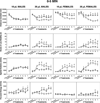Sex differences in behavior and expression of CGRP-related genes in a rodent model of chronic migraine
- PMID: 21521205
- PMCID: PMC4079043
- DOI: 10.1111/j.1526-4610.2011.01882.x
Sex differences in behavior and expression of CGRP-related genes in a rodent model of chronic migraine
Abstract
Objective: The objectives of this study were to develop a preclinical rodent model that produces migraine-like behaviors based on International Headache Society diagnostic criteria, to determine whether sex differences are present, and to determine whether expression of calcitonin gene-related peptide (CGRP) and the genes encoding its receptor in trigeminal ganglion or medulla correlates with those behaviors.
Background: Few animal studies of migraine have tested behaviors associated with migraine diagnostic criteria. In this study, changes in activity and in mechanical sensitivity of facial regions following application of inflammatory soup (IS) or vehicle (phosphate-buffered saline [PBS]) to the dura were measured to model changes in routine activity and allodynia. CGRP, an important mediator of migraine pathogenesis, and the 3 components of its receptor, calcitonin-like receptor (CLR), receptor activity-modifying protein 1 (RAMP1), and receptor component protein (RCP) mRNAs were quantified in the trigeminal ganglion and medulla to identify baseline sex differences and changes associated with application of IS or PBS to the dura.
Methods: Male and female Sprague-Dawley rats were implanted with a dural cannula. Groups of rats were treated with 10 or 20 µL volumes of IS or PBS. Baseline behavioral testing was conducted prior to surgery and again at 7 days postsurgery, and dural application of IS or PBS was performed repeatedly for a total of 8 applications. Locomotor activity was assessed using force plate actimetry during and following application to provide information on distance traveled, bouts of low mobility, spatial confinement, and focused energy. Periorbital and perimasseter sensory testing was performed 20 minutes post-application to measure allodynia. The rats were sacrificed 30 minutes following the final dural treatment, tissue was dissected and total RNAs were isolated from ipsilateral trigeminal ganglia and ipsilateral medulla. Quantitative real-time polymerase chain reactions were used to measure the expression of amplified constructs using gene-specific primers for CGRP, RAMP1, CLR, and RCP.
Results: Both males and females showed behavioral effects of IS application, but there were pronounced sex differences. Females showed effects at the lower dose, and activity changes were present for a longer duration, but males required fewer applications of IS to exhibit behavioral changes. Females showed increased withdrawal responses for periorbital and perimasseter mechanical testing (10 µL IS groups), and males showed increased perimasseter withdrawal responses (20 µL IS group). In the trigeminal ganglion, there were no baseline sex differences in CGRP-encoding mRNA, but females had lower baseline expression of RAMP1, CLR, and RCP-encoding mRNAs. In the medulla, females had higher baseline levels of CGRP-encoding mRNAs and lower baseline levels of RAMP1, CLR, and RCP-encoding mRNAs than males. Both IS and PBS increased expression of mRNAs encoding CGRP, RAMP1, RCP, and CLR in the trigeminal ganglion in males, but in females, only CLR and RCP were increased. In the medulla both IS and PBS increased expression of CGRP, CLR in males and CLR and RCP in females. Thus, expression of CGRP-related genes did not mirror the behavioral differences between IS and PBS groups. Instead, CGRP-related genes were upregulated by both IS and PBS applications.
Conclusions: This study demonstrates significant changes in locomotor activity and facial allodynia associated with application of IS to the dura as well as significant sex differences, demonstrating that International Headache Society diagnostic criteria can be used to design a rodent behavioral model of migraine. In addition, there were prominent baseline sex differences in expression of CGRP and its receptor in both the trigeminal ganglion and medulla, but the majority of changes in expression of CGRP and its receptor were present in both the IS and PBS treated rats. This suggests that the CGRP pathway responds to changes in intracranial pressure or meningeal stretch, while migraine-like behaviors occur after meningeal inflammation.
© 2011 American Headache Society.
Conflict of interest statement
Conflict of interest statement: NLS: No Conflict., EG: No Conflict., MKW: No Conflict., YH: No Conflict., KM’C: No Conflict., NEJB: Conflict of Interest: Consultant for MAP Pharmaceuticals, financial interest less than $10,000; grant support from Merck and Co., Inc, honoraria from National Headache Foundation, financial interest less than $10,000.
Figures







References
-
- Bigal ME, Lipton RB. The epidemiology, burden, and comorbidities of migraine. Neurol Clin. 2009;27:321–334. - PubMed
-
- Stovner L, Hagen K, Jensen R, et al. The global burden of headache: a documentation of headache prevalence and disability worldwide. Cephalalgia. 2007;27:193–210. - PubMed
-
- Rasmussen BK. Migraine and tension-type headache in a general population: precipitating factors, female hormones, sleep pattern and relation to lifestyle. Pain. 1993;53:65–72. - PubMed
-
- The International Classification of Headache Disorders. Cephalalgia. (2nd edition) 2004;24(Suppl 1):9–160. - PubMed
Publication types
MeSH terms
Substances
Grants and funding
LinkOut - more resources
Full Text Sources
Other Literature Sources
Medical
Research Materials

